Overview
Their several reasons I enjoy miniature gaming. It is visually appealing, it is variable, and it is creative. Unlike board games, where you can only fight the same battle over and over, miniature games limit you only to the number of figures and terrain available. You can find figures for any period you can think of from Ancients through Science Fiction.
 When picking out figures the first priority is deciding on a scale. Figure scales
are most commonly measured in millimeters. The scale is the length, in millimeters,
from the bottom of the foot to eye level. The scale can vary from manufacture to
manufacture. The two most popular scales are 15mm and 25mm. A great page for
an overview of all types of miniatures gaming is The Miniatures Page.
When picking out figures the first priority is deciding on a scale. Figure scales
are most commonly measured in millimeters. The scale is the length, in millimeters,
from the bottom of the foot to eye level. The scale can vary from manufacture to
manufacture. The two most popular scales are 15mm and 25mm. A great page for
an overview of all types of miniatures gaming is The Miniatures Page.
The first historical miniatures game I played was an ancients game. This period can be confusing to new comers, because it covers eras ranging from the earliest recorded history through the first widespread use of gunpowder. A good web page to get started with is The Society of Ancients.
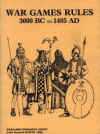 The granddaddy of all ancient rule sets is WRG. It's famous for how incomprehensible
some of it's rules are. It has fallen out of favor due to the difficulty of rules.
However, the army lists that published for the rules, are still some of the best resources
around for designing ancient armies for any rule set. Although I hardly ever play it
anymore, I will always have found memories of games we played with WRG. Due to the
complexity of the rules, official interpretations have been made by the
North American Society of Ancient and Medieval Wargamers (NASAMW).
The granddaddy of all ancient rule sets is WRG. It's famous for how incomprehensible
some of it's rules are. It has fallen out of favor due to the difficulty of rules.
However, the army lists that published for the rules, are still some of the best resources
around for designing ancient armies for any rule set. Although I hardly ever play it
anymore, I will always have found memories of games we played with WRG. Due to the
complexity of the rules, official interpretations have been made by the
North American Society of Ancient and Medieval Wargamers (NASAMW).
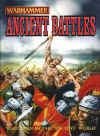 My current favored rule set for Ancients is Warhammer Ancient Battles (WAB). The rules
are not overly complicated and provide for a fun battle. The rules themselves are full
color and chocked full of pictures of beautifully painted armies. They have also released
several supplements focusing on such eras as the biblical period (Chariot Wars) and the late
roman period (Fall of the West). The rules are also the primary motivation for moving to
25mm figures for ancients gaming. A good WAB page is The
Old Sage - Ancient Battles.
My current favored rule set for Ancients is Warhammer Ancient Battles (WAB). The rules
are not overly complicated and provide for a fun battle. The rules themselves are full
color and chocked full of pictures of beautifully painted armies. They have also released
several supplements focusing on such eras as the biblical period (Chariot Wars) and the late
roman period (Fall of the West). The rules are also the primary motivation for moving to
25mm figures for ancients gaming. A good WAB page is The
Old Sage - Ancient Battles.
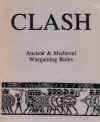 Last but not least is a rule set published by a couple of friends of mine called Clash.
They are simple set of rules that are great for big battles with lots of people. I have seen
games played with thousands of figures and 10 people at once which finished within a couple of
hours. If you like big battles with lots of figures these are for you.
Last but not least is a rule set published by a couple of friends of mine called Clash.
They are simple set of rules that are great for big battles with lots of people. I have seen
games played with thousands of figures and 10 people at once which finished within a couple of
hours. If you like big battles with lots of figures these are for you.
This is period is one of the most prolific periods for war game rules available. The closest thing to a universal set of rules available is Napoleon's Battles. Even this rule set has several detractors. Empire is another popular rule set that, in my opinion, has become more and more complicated as it has moved through it's various editions. There is no one set of rules currently available that has captured the attention of the gaming community. I believe this is due to two reasons.
The first is a matter of scale. Some players want to fight an entire Napoleonic battle, such as Waterloo, in one setting. For this type of game, the standard figure scale is around 1 figure for every 120 men. The standard unit is the brigade. The benefits to this is it puts the players in the role of the army commanders. The downside is the loss of the tactical flavor these rule sets give. The danger with rules based on this scale is trying to include too much tactical feel into the game. Often times rule writers try to include tactical information that a brigade would not be concerned with in one rule, and overly simplify something else that might have a great impact on the very same brigade.
The other alternative are rules were the basic unit is the battalion. The standard figure scale is 1 figure for every 60 men. If you want to fight the battle around Hougomont during the battle of Waterloo this is the scale for you. These give you a much more intimate feel, but the trade off is most battles are not going to be much larger than a corps per side.
The second is the complexity of the rules. Some players enjoy simple games and others want to simulate every experience and possible outcome. The trick has been coming up with a set of rules that is simple, but takes into account the important factors. When can a unit form square, who can issue orders and when, what factors come into play in a fire fight? These are just a few of the questions that must be answered. Some rules might have just a few pluses and minuses to a six sided die row, and others might involve working through a flow chart and then rolling percentile dice to resolve the outcome.
Nobody can agree what the correct mix is, so you end up with hundreds of rule sets that all try and focus on whatever the authors think is important. The two main rule sets I have been playing of late are Napoleon's Battles and From Valmy to Waterloo Light.
 In Napoleon's Battles the basic unit is the brigade. The rules are of medium complexity.
It has a somewhat unique basing system (I use 15mm figures and the base size is 3/4" x 1".
The figures are mounted two by two.) Although it is probably not accurate as far as ground
scale is concerned, it is visually appealing. To be perfectly honest, I have a lot of problems
with these rules, but they are the best I have come across at this scale , and I am just waiting until
a better rule set comes along. They do give a good flavor of the period and have some
interesting ideas. A good link for more information is
The Unofficial Napoleon's Battles Webpage.
In Napoleon's Battles the basic unit is the brigade. The rules are of medium complexity.
It has a somewhat unique basing system (I use 15mm figures and the base size is 3/4" x 1".
The figures are mounted two by two.) Although it is probably not accurate as far as ground
scale is concerned, it is visually appealing. To be perfectly honest, I have a lot of problems
with these rules, but they are the best I have come across at this scale , and I am just waiting until
a better rule set comes along. They do give a good flavor of the period and have some
interesting ideas. A good link for more information is
The Unofficial Napoleon's Battles Webpage.
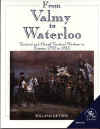 In From Valmy to Waterloo (FVTW) the basic unit is the battalion. The rules are fairly complex,
but I have been told once you decipher them they are easy to play. I gave up on deciphering them
and just went with a play test version that trades off a lot of the complexity for ease of play.
The rules are inspired by the book With Musket, Cannon and Sword by Brent Nosworthy. If
you want to know anything about the Napoleonic battlefield, this is the book to read. I can't
recommend it enough. The best web page for FVTW is the
Yahoo Groups Mailing List.
You can download the "Light" version of the rules in the files section. You can also use
the same basing in FVTW as in Napoleon's Battles.
In From Valmy to Waterloo (FVTW) the basic unit is the battalion. The rules are fairly complex,
but I have been told once you decipher them they are easy to play. I gave up on deciphering them
and just went with a play test version that trades off a lot of the complexity for ease of play.
The rules are inspired by the book With Musket, Cannon and Sword by Brent Nosworthy. If
you want to know anything about the Napoleonic battlefield, this is the book to read. I can't
recommend it enough. The best web page for FVTW is the
Yahoo Groups Mailing List.
You can download the "Light" version of the rules in the files section. You can also use
the same basing in FVTW as in Napoleon's Battles.
Many of the same problems of scale that exist in Napoleonic rule sets are also present in Civil War rule sets. However, in this era two main rule sets have risen to the top. For brigade level games, the favored rule set is Fire & Fury, and for regimental rule sets Johnny Reb III is the most popular.
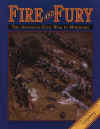 Fire and Fury is one of the prettiest rule sets around. If after looking at the pictures within
the rules, you still don't want to play, this is the wrong hobby for you. The rules use a unique
method of keeping track of the strength of brigades. In most rule sets this is done by keeping
track of the number of figures in the rules, but in Fire and Fury the strength of the unit is the number
of stands within the brigade. This method keeps casualty counters from covering up the figures and
is a much more visually appealing way to do it. The downside is you need a lot of figures. I
enjoy Fire and Fury, but as with most rule sets that are on the brigade level, it suffers from too much
abstraction in some areas, and not enough in others. All in all, it's a fun rule set that gets the
job done. Here is a good resource for finding more about
Fire & Fury.
Fire and Fury is one of the prettiest rule sets around. If after looking at the pictures within
the rules, you still don't want to play, this is the wrong hobby for you. The rules use a unique
method of keeping track of the strength of brigades. In most rule sets this is done by keeping
track of the number of figures in the rules, but in Fire and Fury the strength of the unit is the number
of stands within the brigade. This method keeps casualty counters from covering up the figures and
is a much more visually appealing way to do it. The downside is you need a lot of figures. I
enjoy Fire and Fury, but as with most rule sets that are on the brigade level, it suffers from too much
abstraction in some areas, and not enough in others. All in all, it's a fun rule set that gets the
job done. Here is a good resource for finding more about
Fire & Fury.
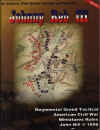 Johnny Reb is one of my favorite rule sets. I started playing it with Johnny Reb II, and switched
over to III when they came out. JRIII cleans up a lot of the complicated rules of JRII and provides
for a fast, fun game. New players usually command a brigade of four regiments of infantry and a
battery of artillery. The rules contains one of my favorite lines that states to the effect if,
"don't worry about new players not knowing how to use their units effectively, most civil war
generals didn't know how to use their units effectively either when they started out." Two
good web pages for Johnny Reb III are The
Johnny Reb III Page and the Yahoo
Groups Mailing List.
Johnny Reb is one of my favorite rule sets. I started playing it with Johnny Reb II, and switched
over to III when they came out. JRIII cleans up a lot of the complicated rules of JRII and provides
for a fast, fun game. New players usually command a brigade of four regiments of infantry and a
battery of artillery. The rules contains one of my favorite lines that states to the effect if,
"don't worry about new players not knowing how to use their units effectively, most civil war
generals didn't know how to use their units effectively either when they started out." Two
good web pages for Johnny Reb III are The
Johnny Reb III Page and the Yahoo
Groups Mailing List.
Once again, the scale of the game you want play determines what rule set to use. I enjoy playing at two different scales; the battalion level and the squad level. At the battalion level, each stand and vehicle represents a platoon. This scale allows you to recreate battalion through regimental level games. Every know and then monster games are run at this scale. For example I have seen the entire Arnheim "Bridge To Far" campaign fought out over several days on several tables. At the squad level, each figure represents one man or vehicle. The climatic battle scene from Saving Private Ryan is a good example of the scale these games are fought.
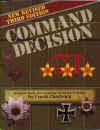 Command Decision III is probably my favorite rule set. I started out playing Combined Arms, which
was the modern era equivalent of Command Decision. I then moved to Command Decision II and finally
III. The biggest change in the rule system came with the third edition, which sped up play and added
a little more realism to game without adding complexity. I've been playing one version of these rules
or another for about as long as I have been war gaming. I really enjoy playing campaigns with this
rule set and one that I had a lot of fun with recently was the
Race For Tunis
campaign game. For more information the best web page for Command Decision is Barry L. Geipel's
Command Decision web page. In
addition, I have collected some more information on my
Command Decision Support Page.
Command Decision III is probably my favorite rule set. I started out playing Combined Arms, which
was the modern era equivalent of Command Decision. I then moved to Command Decision II and finally
III. The biggest change in the rule system came with the third edition, which sped up play and added
a little more realism to game without adding complexity. I've been playing one version of these rules
or another for about as long as I have been war gaming. I really enjoy playing campaigns with this
rule set and one that I had a lot of fun with recently was the
Race For Tunis
campaign game. For more information the best web page for Command Decision is Barry L. Geipel's
Command Decision web page. In
addition, I have collected some more information on my
Command Decision Support Page.
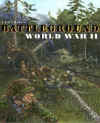 Battleground World War II is a fun rule set for skirmish games. One problem with skirmish games
is that a lot of rules end up making the game so complicated it takes an hour to get through one 15
second turn. Battleground does not suffer from this problem. It gives a lot of the flavor
of World War II without bogging the game down in a myriad of rules. It's a fun, quick game that
is supported very well by the company who publishes the rules,
Easy Eight.
Battleground World War II is a fun rule set for skirmish games. One problem with skirmish games
is that a lot of rules end up making the game so complicated it takes an hour to get through one 15
second turn. Battleground does not suffer from this problem. It gives a lot of the flavor
of World War II without bogging the game down in a myriad of rules. It's a fun, quick game that
is supported very well by the company who publishes the rules,
Easy Eight.
Space combat games can be lot a fun. They let you mix modern naval warfare with lasers, and you don't have to let picky little things like physics getting in the way of a good game. One of my favorite sci-fi shows on TV was Babylon 5. It was like a soap opera for guys. I got so wrapped up in it, I hated to miss an episode in case some new development crept into the show. It was famous for making a fleeting reference to something in one episode that would turn out to be very important to the plot 10 episodes later. When Babylon 5 Wars first came out, I bought it and have enjoyed playing it since then.
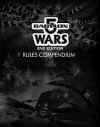 Babylon 5 Wars puts you in the place of a ship captain in the Babylon 5 universe. You can run any
where from one ship to a fleet without to much trouble. The rules have been through two editions
and has had many supplements. Luckily, now you can buy the complete rules in one book. In
addition to Babylon 5 Wars, the authors have released Fleet Action, which allows you run very large
fleet battles, and GROPOS, which is their ground combat rule set. The game is expanding to the
point that you can play an entire planetary conquest from start to finish if you want. The
publishers, Agents of Gaming, have a great
web page that offers a lot of support for their games.
Babylon 5 Wars puts you in the place of a ship captain in the Babylon 5 universe. You can run any
where from one ship to a fleet without to much trouble. The rules have been through two editions
and has had many supplements. Luckily, now you can buy the complete rules in one book. In
addition to Babylon 5 Wars, the authors have released Fleet Action, which allows you run very large
fleet battles, and GROPOS, which is their ground combat rule set. The game is expanding to the
point that you can play an entire planetary conquest from start to finish if you want. The
publishers, Agents of Gaming, have a great
web page that offers a lot of support for their games.
Easy Eight
The Unofficial Napoleon's Battles Webpage
From Valmy To Waterloo Yahoo Groups Mailing List
Fire & Fury
The Johnny Reb III Page
Johnny Reb III Yahoo Groups Mailing List
Race For Tunis
Command Decision
The Society of Ancients
North American Society of Ancient and Medieval Wargamers